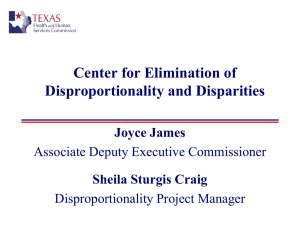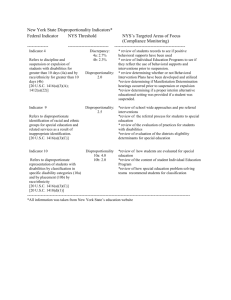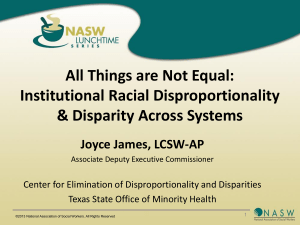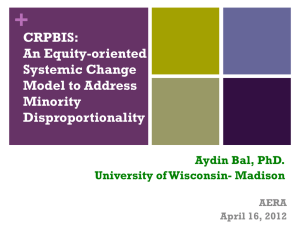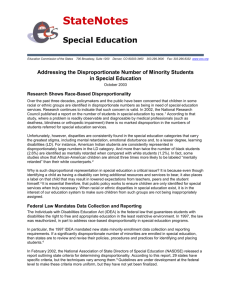Presentation slides – Joyce James
advertisement
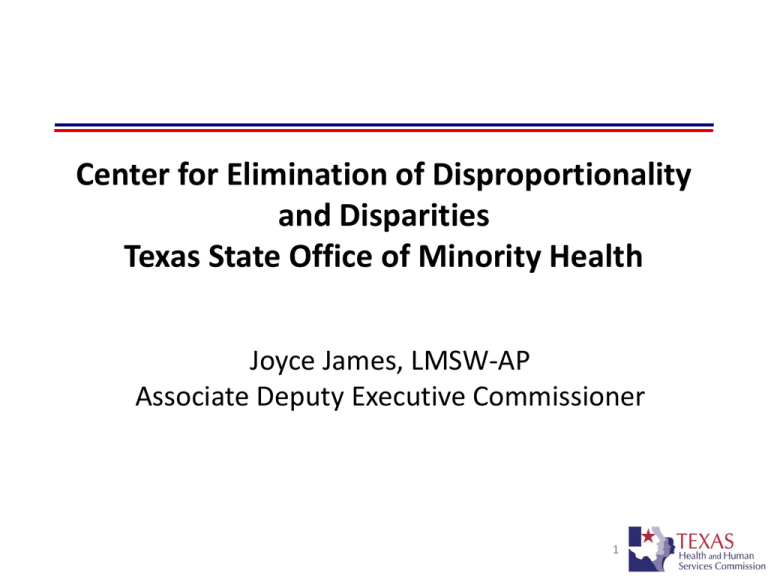
Center forofElimination of Disproportionality Overview the Texas Model for Eliminating and Disparities Disproportionality and Disparities Texas State Office of Minority Health Joyce James, LMSW-AP Associate Deputy Executive Commissioner 1 Mission • The mission of the Center is to partner with health and human services agencies, external stakeholders, as well as other systems and communities to identify and eliminate disproportionality and disparities affecting children, families, and vulnerable populations. 2 Many terms are used to describe racial inequity in outcomes across systems Term Definition Most commonly used in: Disproportionality The comparison of persons of a certain race or ethnicity in a target population (e.g., African American children) to persons in a reference (or base) population (e.g., Anglo children).1 Child welfare The comparison of persons of a certain race or ethnicity experiencing an event to the representation of persons of another race or ethnic group experiencing the same event.2 Health Health Disparity A particular type of health difference that is closely linked with social or economic disadvantage. Health disparities adversely affect groups of people who have experienced greater social or economic obstacles to health based on their racial or ethnic group, religion, socioeconomic status, gender, mental health, cognitive, sensory, or physical disability, sexual orientation, geography, or other characteristics historically linked to discrimination or exclusion. 3 Health DMC – Disproportionate minority contact The disproportionate number of minority youth that come into contact with the juvenile justice system Juvenile justice Achievement gap The observed disparity on a number of educational measures between the performance of groups of students Education Disparity Source: 1. Myers, 2010. 2. Ibid. 3. http://www.hhsc.state.tx.us/hhsc_projects/cedd/ ojjdp.gov/dmc; NEA, “Disproportionality: Inappropriate identification of Culturally and Linguistically Diverse Children,” 3 Disparities and disproportionality are linked Disparity in actions (eg. treatment, services) Disproportionality in systems or statuses Disparity in action (eg. treatment, services) Disparity / Disproportionality in outcomes Education More likely to receive a discretionary disciplinary referral Disproportionality in college classrooms African Americans more likely to drop out African Americans less likely to have bachelors degree CPS African Americans more likely to be removed by CPS Disproportionality in number of children in substitute care African Americans less likely to exit care African American youth more likely to age out of care Juvenile Justice African American youth more likely to be arrested Disproportionality in # of juvenile court cases African Americans more likely committed to corrections Disproportionality in juvenile detention centers Criminal Justice African Americans more likely to be arrested for criminal charges Disproportionality in # of criminal cases Africans Americans more likely sentenced to prison African Americans more likely to be in prison Health African Americans less likely to undergo diabetes screening Disproportionality in type 2 diabetes diagnoses African Americans less likely to receive adequate treatment African Americans twice as likely to die from diabetes Source: Disproportionality in Child Protective Services: The Preliminary Results of Statewide Reform Efforts in Texas; www.diabetes.org; minorityhealth.hhs.gov; Harris, Jackson, O’brien, and Pecora, “Disproportionality in education and employment outcomes of adult foster care alumni”; nces.ed.gov 4 History • 1996 – beginning of work at regional level • 2004 – statewide expansion • 2005 - Senate Bill 6 • 2007 - Senate Bill 758 • 2010 - creation of the Center by Executive Commissioner Tom Suehs • 2011 - Senate Bill 501 5 5 The Texas Model Data-driven Strategies Regularly collect, research, analyze, and evaluate data in line with C.E.D.D. approach Leadership Development Grow both systems and community leaders that are courageous and grounded in C.E.D.D. approach Culturally Competent Workforce Develop workforce that reviews and examines its work through an anti-racist and humanistic lens Community Engagement Recognize strengths of grass roots community, hear its ideas, and include it throughout process Cross Systems Collaboration Share data, training, and dialogue with systems, institutions, and agencies that serve same populations Training Defined by Anti-Racist Principles Train ourselves and partners in principles that ensure we work at cultural and institutional levels An Understanding of the History of Institutional Racism and the Impact on Poor Communities and Communities of Color Develop common analysis of racism and history that led to current outcomes 6 The Texas Model closely resembles existing models designed to address health disparities Community Engagement and Anti-Racist Principles Comparison of missions of major health disparities initiatives and the Texas Model 7 Sources: www.healthypeople.gov; http://minorityhealth.hhs.gov/npa/, ‘overview of OEHD.pdf’ Questions? Thank you Center for Elimination of Disproportionailty and Disparities Texas State Office of Minority Health 4900 North Lamar Boulevard, Suite 1100, MC 1479 Austin, Texas 78751 512-424-6509 8
